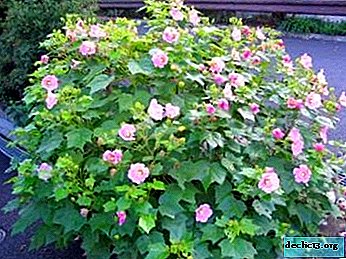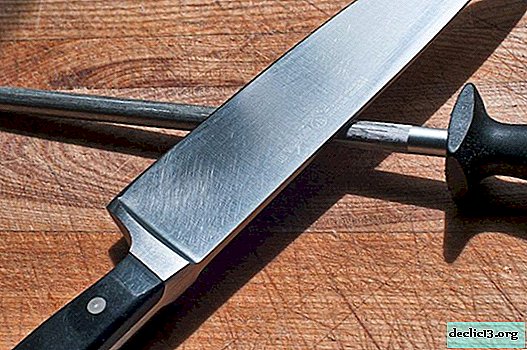"Crazy rose" or hibiscus mutable: description and photo, features of reproduction and care of the flower

Hibiscuses are spectacular representatives of the Malvovs, distant relatives of garden mallow and cotton.
They are often grown in botanical and winter gardens, however, variable hibiscus are great for growing at home.
His main feature, for which he was called the "crazy rose", amazes many. In the article we will tell you how to care for this flower at home, how to propagate and what diseases and pests can affect the plant.
Botanical Description
Variable hibiscus (lat. Hibiscus Mutabilis) - a species of plants from the family of the Malvaceous genus Hibiscus. Also known under the names "crazy rose", Chinese hibiscus and lotus tree. Its historical homeland is the southern regions of China. It has been used since ancient times as a medicinal plant, and also used in the manufacture of ropes, ropes, as a natural dye. In medieval China, the flowers of a crazy rose were a symbol of prosperity and a strong marriage.
In Europe, the plant was introduced at the end of the 18th century, a little later it appeared in Russia. as a decorative. Very quickly, the lotus tree gained its popularity due to its unpretentiousness and appearance.
In the natural habitat, variable hibiscus can reach a height of up to 4 meters. Annual growth is 30-35 cm, depending on climatic and weather conditions. This is an evergreen or semi-deciduous woody plant with a wide spreading crown of an umbrella type. Petiole leaves (up to 30 cm), large, about 25 * 25 cm in size, velvety pubescent, 5- or 7-lobed. The edges are serrated. The color of the foliage is dark green.
The flowers are large, from 5 to 30 cm in diameter, with a brightly colored corolla. A characteristic feature of the plant is a change in the color of the corolla during the life of the flower: in the state of the bud they are pale cream, pink as they bloom, and become purple by the end of flowering. Flowering lasts for three days. For this feature, the plant was called "crazy rose."
Photo
The following is a photo of mutable hibiscus.



Home Care
The composition of the soil and the capacity for growing
Hibiscus prefer neutral soils for growing. Either purchased ready-made soil mix for ornamental shrubs or a self-made substrate of the following composition are suitable for this:
- turf, leaf or pine land (1 part);
- sand;
- humus (1 part);
- peat (1 part);
- charcoal in small quantities.
Small hibiscuses are suitable for small pots; as they grow, the crazy rose needs to be transplanted into more spacious pots with a pallet. It is important that there is drainage at the bottom of the tank - small pebbles, crushed brick, etc.
Watering
Hibiscus is demanding on soil moisture and the environment. Despite the fact that they tolerate drought, for abundant flowering it is necessary to maintain the correct water balance of the plant.

- Watering is carried out with water at room temperature, well-maintained tap or rain.
Watering hibiscus is recommended as the topsoil in the pot dries.
- After watering, after an hour and a half, light loosening of the soil is recommended to reduce moisture evaporation.
- To maintain moisture, the plant is sprayed daily, if possible without getting water on the flowers and buds.
Temperature and light
The plant prefers heat and diffused light. In the summer, it can be taken out to the balcony or terrace, creating a slight shade, in winter it can be moved to the southeast window.
The optimum temperature for hibiscus vegetation is 20-25 degrees, however, the plant must be protected from drafts and temperature extremes. In winter, for the correct formation of the kidneys, the optimal regime will be 14-16 degrees.Top dressing
Crazy rose needs regular feeding - in the spring and summer, fertilizers need to be applied 1-2 times a week, in winter and autumn, reduce the amount to 1 time in 7-10 days.
- In the spring-summer period, alternating potassium and nitrogen fertilizers must be introduced into the soil, they accelerate the formation of buds and increase the flowering time.
- During the flowering period, phosphorus-free mineral fertilizers are introduced into the soil.
Pruning
Pruning is carried out after flowering, before the hibiscus leaves during dormancy. The main rule is to hold it before the formation of flower buds. The lotus tree tolerates deep pruning well. Dry shoots are removed as soon as they are detected.
Step-by-step instruction: Variable hibiscus can be formed in the form of a tree or bush.
The pruning approach is different in both cases.

- To form a shrub:
- On the central branch, several buds are counted from below, which will start to grow.
- The branch is cut with a sharp pruner or knife.
- To form young shoots, long branches are bent to a horizontal position and fixed.
- To shape a tree:
- Young lateral shoots are removed, leaving only the central branch.
- The upper part of the central branch is cut by 1/3.
Transfer
The transplantation is carried out once a year by transshipment method:
- Before transplanting 2-3 days carry out abundant watering of the soil around the plant, avoiding stagnation of water.
- The plant is removed from the pot along with an earthen lump.
- Visually inspect accessible roots without destroying the earth. Rotten or diseased roots are cut with a sharp knife or secateurs.
- The topsoil not captured by the root system is removed.
- Transfer the plant to a new pot, sprinkle with fresh soil and compact.
- Watering after transplantation is carried out through the pan.
Wintering
For active flowering in the summer, it is important to properly care for the plant in winter at rest. To do this, the following rules are observed:
- temperature 14-16 degrees (not lower than +10);
- watering once every 10-14 days, with dry air - once every 7-10 days;
- ambient light for at least 8 hours per day.
Breeding
When growing variable hibiscus, two methods of reproduction are used: seeds and cuttings. Let's consider both ways.
Seeds
 Spend from mid-January to April.
Spend from mid-January to April.
- Seeds are soaked for 10-12 hours in room temperature water. You can use growth activators for indoor plants.
- The prepared soil is moistened, 1-2 days before planting, organic and mineral fertilizer is introduced into it.
- Sow seeds in peat pots or in wide boxes at a distance of 3-4 cm from each other.
- A container with seeds is covered with a plastic film to create a greenhouse effect.
Cuttings
Spend in February-April or July-September.
- Cuttings with 2-3 internodes (distances on the trunk between leaves) are cut from the tops of the side shoots of the second year of life.
- Rooting is carried out for a month in a container of water or in pots of earth under a glass jar.
- After the formation of the root system, the cuttings are planted in the prepared soil.
- Planted cuttings are placed on a sunny window.
- Watering the cuttings is carried out using a spray gun.
Diseases and Pests
Most often, hibiscus are affected by a spider mite and aphids. If pest damage is suspected, the plant is given a shower of warm water and then sprayed with a soapy solution. In advanced cases, the use of insecticides is allowed.Among the diseases of a crazy rose, it most often occurs:
- leaf chlorosis;
- burns of the root system with mineral fertilizers.
Problems with flowering and growth can also be caused by errors in care:
- insufficient watering;
- overfeeding with nitrogen fertilizers;
- dry air
- lack of minerals.
Similar flowers

- Tahitian hibiscus - varietal hibiscus with different color corollas.
- Marsh hibiscus - a plant with huge flowers with bicolor petals.
- Hibiscus sparkling - got its name for a wide range of colors in the corolla of flowers.
- Hibiscus cooper - has variegated foliage.
- Hibiscus indian - almost no different from variable, the only difference - does not change color.
Hibiscus mutable is picky, but requires thoughtful quality care. A competent conscientious flower grower will be rewarded with many years of abundant flowering of a strange, but very beautiful plant.

















